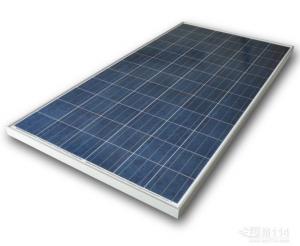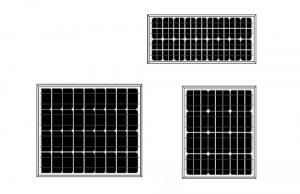SDS Solar Panels 36W Mini Monocrystalline High Efficiency CNBM
- Loading Port:
- Qingdao
- Payment Terms:
- TT OR LC
- Min Order Qty:
- 10 set
- Supply Capability:
- 300000 set/month
OKorder Service Pledge
OKorder Financial Service
You Might Also Like
Mini Monocrystalline Solar Panel with 36W


Monocrystalline Solar Modules
We offers a range of small, medium and large monocrystalline solar modules, designed for a range of requirements.
Specifications:
Tolerance | +/- 3% |
Cell | Monocrystalline silicon solar cells |
N0. of Cells | 72 (12 x 6) |
Dimension of Modules (mm) | 1581 x 809 x 40 |
Weight (kg) | 15.5 |
Limits:
Operating Temperature | -40~+85? |
Storage Temperature | -40~+85? |
Maximum System Voltage | 1000 VDC max. |
Hail Impact | Diameter of 28mm with impact speed of 86km/h |
Temperature and Coefficients:
NOCT | 48C+/-2? |
Voltage temperature coefficient (%/K) | -0.34 |
Current temperature coefficient (%/K) | 0.09 |
Power temperature coefficient (%/K) | -0.37 |
Characteristics:
Model: | SGM-160D | SGM-165D | SGM-170D |
Max-power voltage Vmp (V) | 34.5 | 35.4 | 35.8 |
Max-power current Imp (A) | 4.64 | 4.66 | 4.75 |
Open-circuit voltage Voc (V) | 41.75 | 43.6 | 43.32 |
Short-Circuit Current Isc (A) | 5.32 | 5.08 | 5.38 |
Max-power Pm(W) | 160 | 165 | 170 |
Model: | SGM-175D | SGM-180D | SGM-185D |
Max-power voltage Vmp (V) | 36.1 | 36.2 | 36.2 |
Max-power current Imp (A) | 4.85 | 4.97 | 5.11 |
Open-circuit voltage Voc (V) | 43.68 | 43.8 | 44.8 |
Short-Circuit Current Isc (A) | 5.49 | 5.48 | 5.51 |
Max-power Pm(W) | 175 | 180 | 185 |
STC: Irradiance 1000W/m2, Module temperature 25?, AM=1.5
Monocrystalline Solar Panels Specifications Range
Maximum Power (Pm) | Dimension | Weight | Operating Voltage (Vmp) | Operating Current (Imp) | Open Circuit Voltage (Voc) | Short Circuit Current (Isc) |
3W | 158x241x25mm | 0.5kg | 8.5V | 0.36A | 10.5V | 0.4A |
4W | 308x166x25mm | 0.77kg | 8.5V | 0.47A | 10.5V | 0.54A |
4W | 308.x166x25mm | 0.77kg | 16.8V | 0.24A | 21V | 0.27A |
5W | 296x215x25mm | 0.3kg | 16.8V | 0.48a | 21V | 0.54A |
10W | 286x406x25mm | 1.5kg | 16.8V | 0.59A | 21V | 0.66A |
12W | 286x406x25mm | 1.5kg | 16.8V | 0.71A | 21V | 0.8A |
14W | 286x541x25mm | 2kg | 16.8V | 0.83A | 21V | 0.96A |
16W | 286x541x25mm | 2kg | 17.2V | 0.93A | 21.5V | 0.99A |
18W | 296x541x25mm | 2.4kg | 18.8V | 1.07A | 21V | 1.2A |
20W | 296x641x25mm | 2.4kg | 17.2V | 1.15A | 21.5V | 1.24A |
24W | 541x451x25mm | 3.15kg | 16.8V | 1.14A | 21V | 1.56A |
26W | 541x451x25mm | 3.15kg | 17.2V | 1.51A | 21.5V | 1.63A |
30W | 296x966x25mm | 3.85kg | 16.8V | 1.78A | 21V | 2.03A |
36W | 541x641x35mm | 4.7kg | 16.8V | 2.14a | 21V | 2.4A |
40W | 541x641x35mm | 4.7kg | 17.2V | 2.33A | 21.5V | 2.5A |
55W | 1057x457x35mm | 6.6kg | 17.6V | 3.12A | 21.6V | 3.3A |
70W | 546x1196x35mm | 8.5kg | 16.8V | 4.15A | 21V | 4.7A |
75W | 546x1196x35mm | 8.5kg | 17.2V | 4.36A | 21.5V | 4.8A |
80W | 546x1196x35mm | 8.5kg | 17.6V | 4.55A | 21.6V | 4.9A |
110W | 1066x811x40mm | 11.8kg | 17.6V | 6.25A | 21.6V | 6.6A |
150W | 1066x811x40mm | 14kg | 34.4V | 4.36A | 43.2V | 4.7A |
- Q: Can solar panels be installed on a golf course or clubhouse?
- Yes, solar panels can be installed on a golf course or clubhouse. The large open spaces and ample sunlight make it an ideal location for harnessing solar energy. Installing solar panels can help generate clean and sustainable electricity, reducing reliance on traditional power sources and potentially lowering energy costs for the golf course or clubhouse.
- Q: Where can I find good instructions to build a cheap solar panel on my own?
- Lowe's has some good plans, i built one using a 4'x8' sheet of foam in a box 6 tall cut grooves in the foam paint it with Black latex paint put a inlet and outlet at opposite ends of the box 4 in dia cover the box with a clear sheet of plastic put a screen over the hole in the top a duct in the bottom with a fan hooked to a temp switch , [hint a fan limit switch out of an old furnace works ] run the fan duct in to the house
- Q: Can solar panels be used for powering electric lawnmowers or gardening tools?
- Yes, solar panels can be used to power electric lawnmowers or gardening tools. By connecting the solar panels to a battery storage system, the energy collected from the sun can be stored and used to power these tools, providing a sustainable and environmentally friendly alternative to traditional power sources.
- Q: How do solar panels affect the local job market?
- Solar panels can have a positive impact on the local job market by creating new employment opportunities. The installation, maintenance, and manufacturing of solar panels require skilled and unskilled workers, thus stimulating job growth in the renewable energy sector. Additionally, the shift towards solar energy can lead to the creation of new businesses and industries, further contributing to job creation and economic development in the local community.
- Q: Can solar panels be used in areas with high levels of dust storms?
- Yes, solar panels can still be used in areas with high levels of dust storms. However, it is important to ensure regular maintenance and cleaning of the panels to prevent dust accumulation, which can reduce their efficiency.
- Q: Thanks
- Solar energy is a renewable energy resource and there are no fuel costs. No harmful polluting gases are produced. Disadvantages Solar cells are expensive and inefficient, so the cost of their electricity is high. Solar panels may only produce very hot water in very sunny climates, and in cooler areas may need to be supplemented with a conventional boiler. Although warm water can be produced even on cloudy days, neither solar cells nor solar panels work at night.
- Q: I have heard you can make your own solar panels.... But How?Where do you start? Is it cheap, or should I just BUY them already made?
- A few months ago my wife and I were going through the same thing. We ended up purchasing a small PV set as a trial basis but then we realized that it would take waaaay too long to pay back our investment. We started doing some research and ended up buying a few different books/videos on how to make our own solar panels on the cheap. Most of the books are OK (some are pretty terrible, though). We ended up using most of our information from Home Made Energy, check them out: bit.ly/greennrg
- Q: Can solar panels be used for camping or outdoor activities?
- Yes, solar panels can be used for camping or outdoor activities. Portable solar panels are designed specifically for such purposes and provide a convenient and eco-friendly way to generate electricity in remote locations. They can charge batteries or power devices directly, allowing campers to have access to electricity even when they are away from traditional power sources.
- Q: How do solar panels affect the aesthetics of a roof?
- Solar panels can have both positive and negative effects on the aesthetics of a roof. On one hand, the sleek and modern design of solar panels can enhance the overall appearance of a roof, giving it a more futuristic and eco-friendly look. On the other hand, the presence of solar panels can be seen as an obstruction or deviation from the traditional appearance of a roof, which some individuals may find unappealing. Ultimately, the impact on aesthetics will depend on personal preference and the integration of solar panels into the overall design of the building.
- Q: when building a solar panel should the diode be on the positive or negative sidelittle more detail i just built a solar panel and im running it to a grid tie converter should i put diodes in if i add another panel or are they only for battery systems?
- I'm assuming you're talking about the blocking diode and not the bypass diodes. Positive side.
Send your message to us
SDS Solar Panels 36W Mini Monocrystalline High Efficiency CNBM
- Loading Port:
- Qingdao
- Payment Terms:
- TT OR LC
- Min Order Qty:
- 10 set
- Supply Capability:
- 300000 set/month
OKorder Service Pledge
OKorder Financial Service
Similar products
Hot products
Hot Searches
Related keywords


























